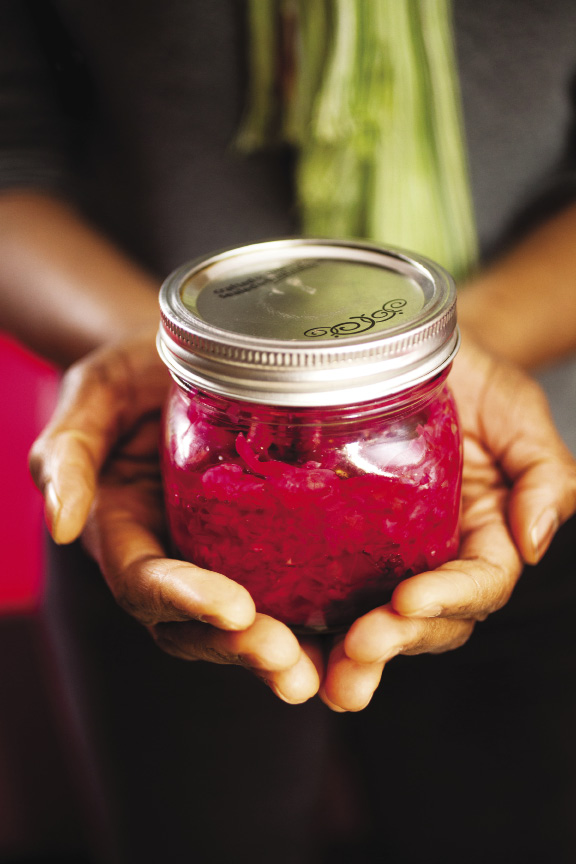Home canning is so 2006. Or so it seemed at the sixth annual fermentation fest organized by Zach Schulman, attended by New York’s most dedicated miso makers, kraut crafters and kombucha connoisseurs.
As far as this crowd is concerned, boiling beans in vinegar, simmering strawberries in sugar or dumping a packet of instant yeast into a bowl of flour and water is barely better than Burger King. Instead, they practice seriously slow food: ancient cooking and preservation techniques that harness wild microbial magic to the benefit of both gustatory flavor and gut flora.
Unlike modern pickling and preserving—which zap microbial activity with a quick-killing combination of high heat, vinegar and/or sugar—fermentation is a slow, living transformation that works with the wild bacteria that surround us. Humans have made use of these processes for at least 8,000 years. Way back when, fermentation meant survival; it was a way of preserving foods that would otherwise spoil before we could consume them. For millennia, people have fermented grape juice into wine, barley into beer, milk into yogurt and cabbage into kimchi, all of which preserved harvests and sustained civilization long before the Icebox Age.
Speaking of life forms multiplying in your kitchen—like-minded eaters have annually crammed into Schulman’s Crown Heights apartment for microbial “cultural exchanges” to sip hard cider, muse about mead, compare kimchi and sample sourdough. But Brooklyn’s fermentation fan base has recently bubbled up like an overfed starter and, as a result, Schulman’s yearly meet-up outgrew his home kitchen. What started with just a dozen friends meeting to swap recipes and share kombucha “mothers” now incorporates how-to lessons like a bread-baking workshop and an advanced home-brewing demo, so this year the group convened at the Brooklyn Free School in Clinton Hill. Seventy-five fermenters showed up, nearly all with something edible in tow—half a dozen tables were soon crammed with DIY crème fraîche, fizzy ginger beer, pickled bok choy, serious sourdough, homemade red wine, old-world vinegar and at least six varieties of creatively named kraut (many of them supplied by Brine and Dine) like “fire kraut,” which had serious heat, or “pretty in pink,” with cranberries and fennel nestled amongst the cabbage, created by Schulman’s partner, HanaKyle Moranz.
“I’m a total parasite,” joked Jordan Baxter, an attendee who arrived empty-handed but gladly hit the buffet of beneficial bacteria. “That’s some hella good yogurt.”
When ferment freaks swap recipes, it can sound more like they’re chatting about the care and feeding of tiny pets—or perhaps a health inspector’s horror films. That’s because these recipes require maintaining an environment in which microbes thrive. Under warm, wet conditions, wild yeasts and bacteria grow quickly and convert sugars into ethanol, carbohydrates into alcohol and carbon dioxide into acids—building blocks for a tangy tub of yogurt or a seriously sour crock of kraut.
And because your own home’s microbes are an essential ingredient, anything you make will be as unique as a snowflake. As explained by Sandor Katz—author of Wild Fermentation, he’s the group’s guru—fermentation is the opposite of homogenization: Every house—even every room—has its own unique ecosystem of localized microbes, and therefore every ferment will have its own terroir and taste.
“Things are smelly and looking delicious!” proclaimed Schulman at the skill-share, as questions surfaced like so many kombucha bubbles: Can leftover miso be used to start a new culture? (No, the salting process inoculates its first koji ferment.) Is fermented okara—the pulp left over after making soy milk—good to eat? (Yes, it can become a base for sausage or a starter for tempeh.)
Many fermenters are enthusiastic not just about fermented foods’ eternal ubiquity but about their health benefits, too. Attendee Angela Davis said changing her diet five years ago worked wonders on her once-troubled digestive tract, and Katz credits these living foods as essential to his own management of HIV. It’s clear that fermented foods promote microbial diversity—or gut flora—in our digestive systems, not to mention enriching foods with protein, essential acids and vitamins.
But while these foods have been dietary staples for millennia, fermentation has fallen from favor in modern times. Fans want to keep these traditions, well, alive, by swapping batches of kvass, kefir, vinegar, tamari, kenkey, tempeh, ginger beer, chicha, mead or poi.
Schulman says the effort of submerging basic ingredients in salt water, inoculating milk to make cheese or maintaining the right temperature for grape-fermenting yeasts to make wine will reward you with results that are intriguing, sublime and literally intoxicating. (For those looking to get into the craft, he recommends Katz’s aforementioned book, Wild Fermentation.)
For the new fermenter, sauerkraut is a popular bacterial baptism. Simply shred cabbage, salt it well, pack it into a crock, cover it with a plate or cheesecloth and leave it at room temperature. Your work is done, and the microbes’ begins. The salt pulls liquid out of the cabbage, and a brine soon fills the crock. This little ecosystem is perfect for wild bacteria like lactobacillus, which get busy converting sugar into lactic acid for several weeks, fundamentally altering the crop in the process. Sauerkraut.
Whether you’re after that ancestral coleslaw, a batch of horseradish pickles or a three-year-aged tub of miso, the results typically taste more tangy, sour and, well, alive than just about anything the supermarket can offer. You might not like all ferments, but considering they include some of the world’s most celebrated foods, there’s probably something for everyone.
Take Shannon Ferguson, who this year brought a batch of pickled green mangoes. She didn’t dig the krauts, she admitted, “but I love the bread and yogurt.”
Photo credit: Emily Dryden



